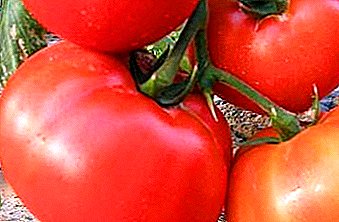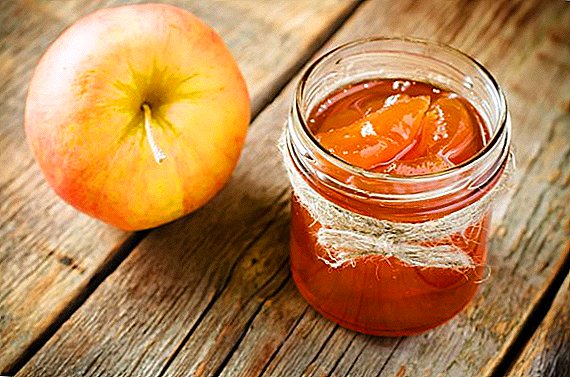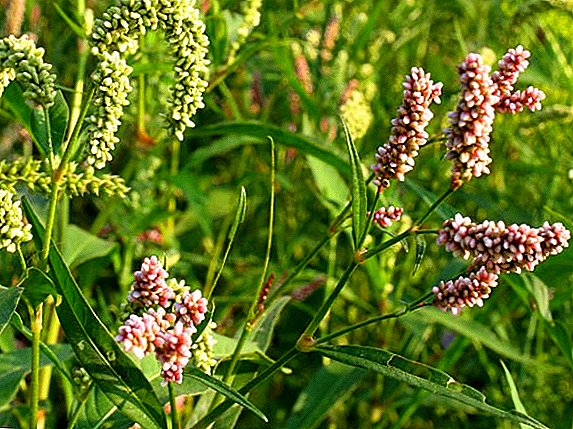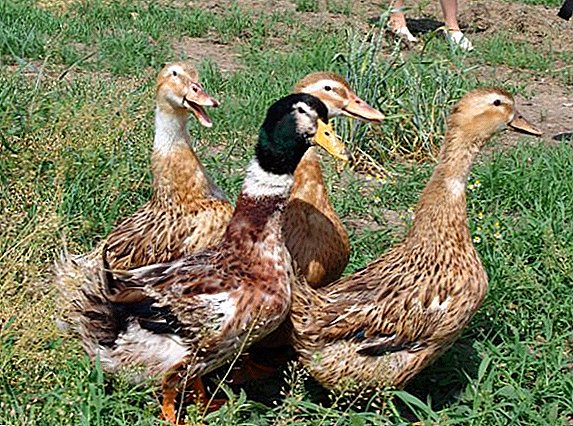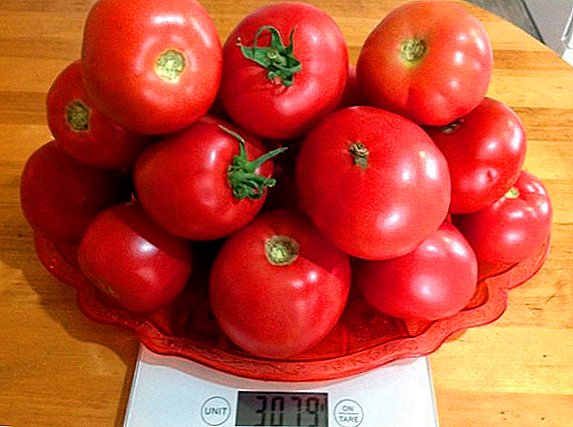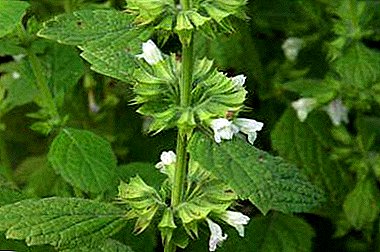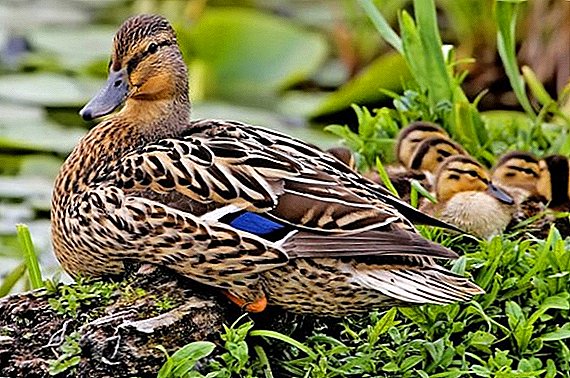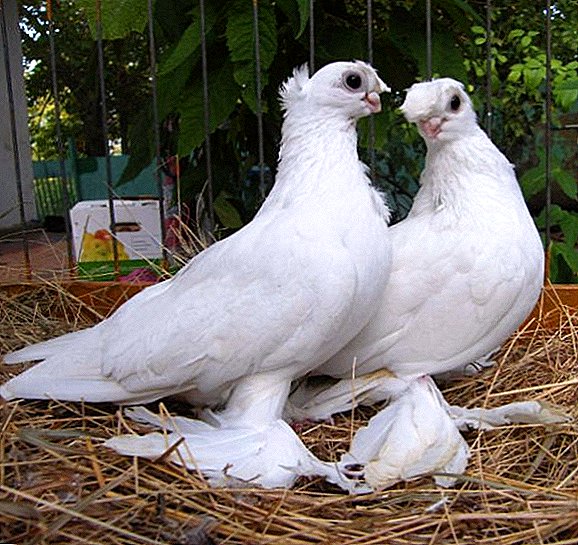 Bob pigeons belong to the subspecies of domestic pigeons. Such a formidable name, these birds received not for fighting qualities, but for the loud sound battle with their wings, which they publish in flight. Representatives of this species not only differ from the rest of the pigeons in their unusual specificity of flight, but also often possess attractive looks.
Bob pigeons belong to the subspecies of domestic pigeons. Such a formidable name, these birds received not for fighting qualities, but for the loud sound battle with their wings, which they publish in flight. Representatives of this species not only differ from the rest of the pigeons in their unusual specificity of flight, but also often possess attractive looks.
Features of the dove
Pigeons are the most popular group preferred by pigeon breeders. Among other ornamental subspecies, martial artists are distinguished by their characteristic features:
- flapping wings in flight are accompanied by loud clicks, as if birds “beat” the air;
- a peculiar highlight of the flight is the unusual game of the pigeon, when the bird performs somersaults;
- the flight has several styles;
- The flight altitude of these birds can be so great that when some individuals enter the pole, they even disappear from view;
- the flight is very long, it can last continuously for several hours (mostly from 3 to 6, but sometimes it can last a whole day), which indicates the exceptional endurance of the birds;
- the flight resembles a virtuoso air game: the bird often changes styles and performs various tricks, which is why it is very interesting to watch this game;
- Birds are able to hover during flight, at this time intensively flapping their wings and making coups:
- martial artists are perfectly orientated to the terrain, they have a good memory for static objects, which allows them to make long flights over long distances;
- This species of pigeons includes a large variety of different breeds, which generally makes the species very variegated, representatives differ in appearance, color, shape and location of feathers;
- Many battle breeds have peculiar feather brushes on their paws, which differ in length from very short to very long, resembling a second pair of wings.
 Boards are hardy by nature, undemanding to conditions of detention and unpretentious to the diet.
Boards are hardy by nature, undemanding to conditions of detention and unpretentious to the diet.Did you know? Pigeons are also called high-flying pigeons, because some members of this species can climb up to 1.5 km, and not every bird can master such a height.
Flight specifics
The flight game of these birds amazes with a variety of styles and tricks performed by birds in the air. The clicks made by the friction wings with the air are quite loud, and they are heard far away. This knock of wings is called a fight.
Breeders, improving the breed of lively pigeons, paid attention only to the techniques of performance of the battle, completely ignoring the appearance of birds. From this, this view is so diverse, some representatives are surprised by an unusual and bright exterior.
However, the main quality in lively pigeons is an air game, which can be of several types:
- Raising the pillar - the main form of pigeon combat. The fact is that the bird quickly, repeatedly and loudly flapping its wings, rises vertically upwards. At the peak of the ascent, he makes a quick roll back, making a 360 ° turn. This element can be repeated many times during the flight or complicated by the use of screw technology. When playing with a raise in a pillar, pigeons can rise vertically upwards by more than 15 meters, sometimes disappearing completely from sight.
- Propeller flight - a kind of raising to the pillar. The bird that accomplishes the screw rises upward in a spiral, gently and with revolutions, as if screwing into the air.
- Hang - another business card of battle flight. It differs from raising to a pole with smoother and softer movements, as well as hovering in the air, when a bird beats its wings while in one place.
- Ribbon flight - It is often considered a marriage among pigeon breeders, because the pigeon does not hang in the air and does not rise up a pillar, but simply flies, flapping its wings.
- Pair flight - performed by birds before laying or when feeding the chicks. It looks especially spectacular because of the synchronicity of the pigeon game.
 There are several criteria by which breeders reject some pigeons:
There are several criteria by which breeders reject some pigeons:- the bird performs air pirouettes, however without soundtrack by combat;
- beats his wings, but does not perform air stunts and coups;
- performs extra rotational movements with a circular flip-flop;
- not capable of 360 ° flipping;
- flips with more than 360 ° flip.
Important! Screw breeds of pigeons are more prone to injury than others, because when they make a screw, they often lose their orientation in space and die from hitting trees or houses.
Popular Breeding Pigeon Breeds
Each breed of warriors is distinguished only by its characteristic features, not only in appearance, but also in flight techniques. Consider the most popular breeds of these birds, which are valued by poultry farmers above the rest.
Baku
For the first time, this species of lively pigeons was formed into a separate breed in the middle of the last century, and the appearance of the “Bakunians” at that time was not impressive - short legs, a hunchbacked back, a nondescript color color. However, in flight, the bird looked great.
Currently, the breeders were able to achieve that the “Bakuvians” retained the flight characteristics of their ancestors, but acquired an attractive appearance. The differences in appearance of the Baku pigeons are numerous.  Among them are chubaty and beschuby, variegated and inconspicuous, with brushes on their feet and without. A common external feature is a medium-long spindle-shaped body, a long beak up to 2.5 cm, tightly pressed and smooth-fingered wings, and an elegant neck.
Among them are chubaty and beschuby, variegated and inconspicuous, with brushes on their feet and without. A common external feature is a medium-long spindle-shaped body, a long beak up to 2.5 cm, tightly pressed and smooth-fingered wings, and an elegant neck.
Familiarize yourself with popular species and breeds of pigeons, as well as learn more about the peculiarities of breeding peacock and Uzbek live pigeons.
However, the main difference between the Baku warriors lies in their incredible endurance. These are strong birds, muscular, capable of rising to unprecedented heights and being in the air for many hours.
In endurance, they could compete even with sport pigeons.
The flight of "Bakuvians" is very diverse and high. Sometimes they rise so high that they become invisible. However, a good orientation to the terrain allows them to always return home.
These birds fly in bulk, do not gather in heaps, preferring to demonstrate their game separately. Go out to the post with 2-3 flips, accompanied by loud claps. In the air, able to hold up to 12 hours.
Main colors:
- white bakintsy - monochromatic white color; they are distinguished by the best flight characteristics;
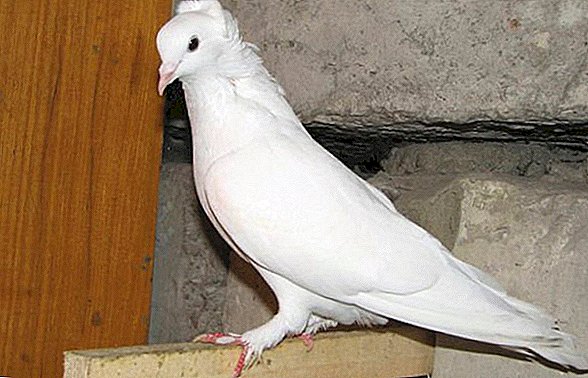
- agbash - they must have a white head, and the rest of the body may be of a different color, may be bare-legged or lochmonogue, broad-headed or smooth-headed;
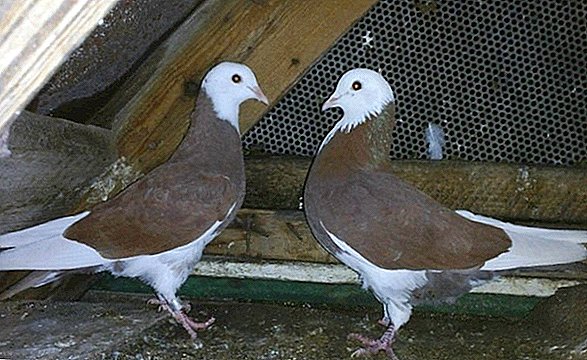
- blacktail - different black or red tail, the color of the rest of the body may be different, but monotonous;

- Chile - they have red and black feathers, a pockmarked neck, and sometimes brushes on the legs, black feathers sometimes have white patches, chubaty individuals are possible, plumage on the chest is purple, thick and dense;
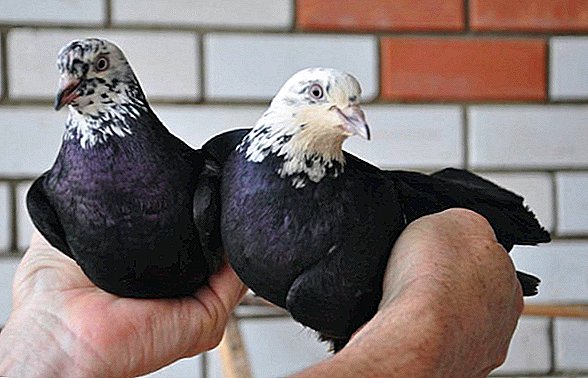
- mirror - they are distinguished by a symmetrical pattern on feathers; colored tails and sides are possible;
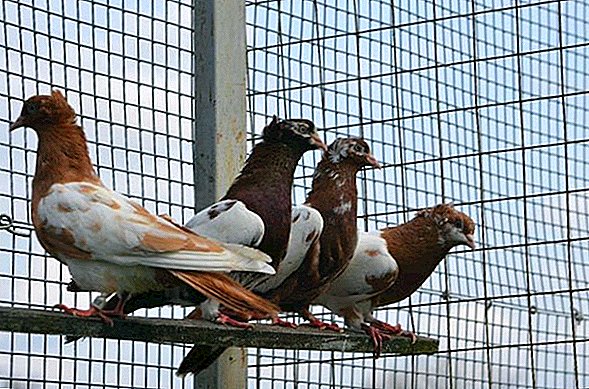
- marble - feathers of different colors alternate in the form of a marble pattern, the main feature - the intensity of color indicates the age of the bird: the younger the individual, the brighter the spots, the dark color indicates the adult age of the pigeon;

- hryvnia - they are characterized by light monotonous plumage and bright neck, often have tuft, which is flowery behind, and always white in front;

- necks - Chubaty rarely, most often white, with cherry eyes and without eyelids, there is always a bright spot on the slightly curved neck.
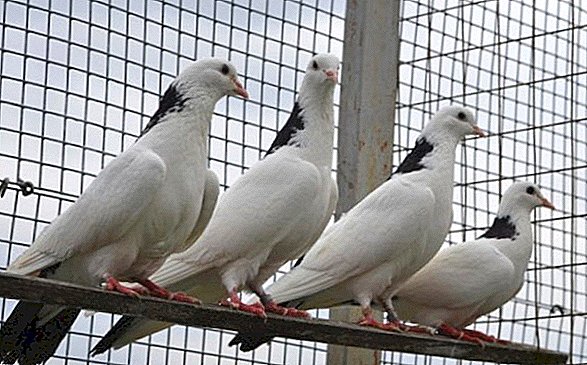
Uzbek (double-faced)
The freedom-loving Uzbek pigeons, like other fighting ones, are capable of performing complex air stunts, staying in the air for a long time and making a loud sound of their wings in the air. But their business card is the presence of a forelock on the head, which is inherent in almost all members of the breed, differing only in the shape of various subspecies.
Double-skinned "Uzbeks" were first bred in the framework of this breed. They are distinguished from others by the extraordinary pomp of plumage. They have thick and fluffy feathers, there are shaggy brushes on the legs, and on the head there is a long forelock, which stretches from the forehead through the entire head and around the neck.  The increased shaggyness gives the impression that the birds have a massive build.
The increased shaggyness gives the impression that the birds have a massive build.
Today, the main goal of breeders improving the breed of double-clawed Uzbek pigeons is to breed even more attractive plumage. These decorative birds are of aesthetic value.
Did you know? Scientists have studied the DNA of modern pigeons and found that they are relatives of the long-extinct dodo bird, which for a long time could not be attributed to any family because of the peculiar structure of the body.
Uzbek pigeons are found in these suits:
- tasmans - have a plumage of coffee color, tail, chest and head darker brown, the breed is considered clean if white is inherent in the nadkhvost, the extreme tail feathers and the outer side of the wings;
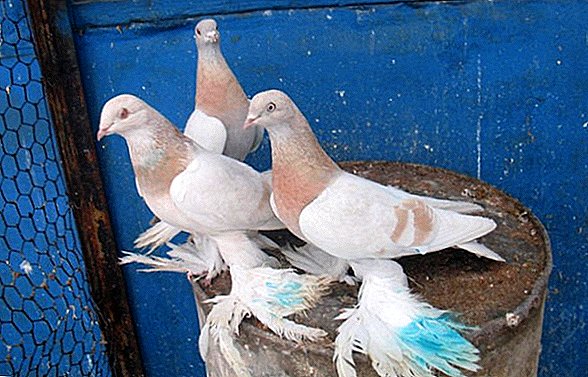
- balkar - they are characterized by an unusual ash tinge of plumage, small black feathers all over the body form a marble pattern;
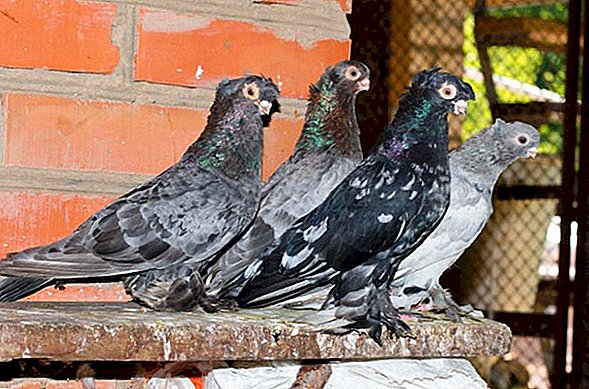
- gulbadam - white with colored patches on the neck, yellow or red chin;
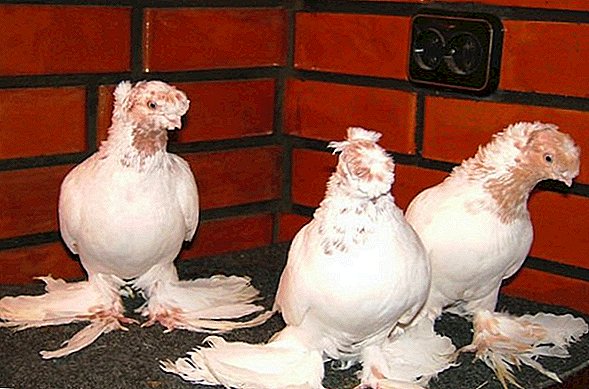
- chinny trap - the main color is white, but on the chest and around the neck the color is red or yellow.
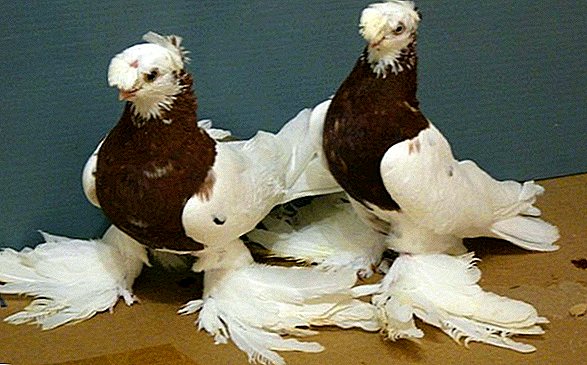
Krasnodar (red)
These pigeons are primarily valued for the aesthetics of their exterior, and not for their flying qualities, which they are low in the sky - they can last only about an hour, although the flight looks stunning.
Externally, the representatives of the breed are very beautiful, neat, have different colors, but the most attractive is red.
Quite often, pigeons are bred for meat, we recommend reading what kinds of meat pigeons are and how to breed them.
These birds are displayed pure color, rich and bright red. However, after the first two molts, only some parts of them remain - the chest, belly, and undertail, the rest of the body becomes white.
Stand in feathery proud, look beautiful and harmonious, physique developed.
Representatives of the Krasnodar breed are flying at medium height both in flocks and individually, in circles. The flight of these birds is smooth and impetuous, they go quietly to the pole. 
Iranian
This is one of the most ancient pigeons that were bred more than 5 thousand years ago. And this is the main feature of the breed. Today, only 5% of the population of the planet own such birds, and they are fabulously expensive.
The Iranian pigeons do not have a specific standard - they are full of different colors, they are chubaty and beschubye, lohmonogie and holonogie, with curly plumage and smooth. Common to all members of the breed is a long beak, a wide tail, in which at least 12 tail feathers and a large wingspan of 60 to 70 cm.  The flight of the “Iranians” is quite long, on average from 3 to 5 hours, although trained individuals are able to hold out in the sky for up to 10 hours. The flight is smooth and slow, they can rise very high, because of what they are considered high-flying.
The flight of the “Iranians” is quite long, on average from 3 to 5 hours, although trained individuals are able to hold out in the sky for up to 10 hours. The flight is smooth and slow, they can rise very high, because of what they are considered high-flying.
A distinctive feature of the Iranian breed is a slow flight with long hangs in one place.
Did you know? On the island of Mauritius live unique pigeons - pink This is the only in the world and very small population of bright pink pigeons. It is believed that the reason for such a bright color lies in the exotic local fruits and berries that these birds eat.
Turkish (takla)
This is the most famous breed of Turkish pigeons. The name "Takla" comes from the word "somersault", which indicates the main feature of these birds. Takla's pigeons are the most virtuosic propellers of a spiral flight, whose wings playing is especially exciting.
It is noteworthy that the propensity to screw depends on the color of the bird - the more faded the plumage, the more beautiful the flight of the screw. Motley individuals may not generally have a propensity for the execution of the screw.
Takla are of several types: double-breasted, nosochubye, long-haired and nosy. The shape of the plumage and colors are different. The flight is high (up to 20 m) and long (up to 10 hours). 
Features of the content of the battle pigeons
Despite the fact that pigeons of war are often unpretentious to the conditions of detention and nutrition, proper care and regular training allow these birds to show unforgettable turns in the sky, lingering in the air for a long time.
In addition, good care is the key to a long life of birds - up to 15 years. There is even a case when a bird could live to 35 years.
For successful breeding of pigeons, it will be useful for you to learn about the features of breeding and feeding pigeons, as well as learn how to equip a pigeon house.
Placement of pigeons
Pigeons can live in cages, dovecotes and aviaries. The main thing is that the premises for keeping birds comply with certain rules:
- must have good ventilation;
- height from floor to ceiling must be at least one and a half meters;
- the size of the enclosure should be calculated on the fact that for each individual bird requires 1.5 square meters. m;
- in the pigeon house there should be perches, and the thickness of the perch should correspond to the girth of the pigeon's foot;
- litter over 5 cm;
- regular cleaning and disinfection at least once a month;
- temperature range from +20 to +30 ° С.

Nutrition and feeding
Feeding birds must be complete and fortified, because this is the guarantee of health and beauty of birds.
Unfortunately, no production feed contains all the elements necessary for pigeons, so they should be given:
- dry grain mixtures: they contain almost all the necessary minerals;
- river sand or small gravel: for this equip a separate feeder, these elements contribute to more efficient grinding of food in the stomach;
- bright-colored millet, rice, wheat and barley contain a large number of trace elements and are recommended for feeding pigeons;
- birds should not be fed corn because of the large size of its grains and oats due to the presence of husk;
- water for pigeons should be warm, room temperature, purified or settled water;
- during the mating period, it is advisable to give cannabis seeds to the birds;
- any vitamin supplements can be replaced with freshly cut greens of nettle, dandelion leaves, spinach and cabbage.
Feeding pigeons is carried out twice a day - in the morning and in the evening, and the feeders after the meal must be taken.
Important! The rate of food per day for a pigeon is 40 g of food, of which 10 g it should receive in the morning before training and 30 g in the evening after training.
Features of training
Although a beautiful flight is laid in the battle rocks at the genetic level, it is still necessary for the birds to be regularly trained to hone their skills and develop endurance.
- Schooling pigeons to fly must begin on the 40th day of their life. If you start releasing birds earlier than this period, when they are still not strong enough, then it is fraught with the fact that the birds will “slaughter” or stop the game altogether.
- Gon pigeons are usually limited to 15 individuals.
- Departures are not limited to the time of year and are carried out both in winter and in summer. For tumbling individuals, regular training is important.
- The pigeons start beating at different ages: early ones - at 2-3 months, late ones - in the third year of life. The later the bird began to "beat", the more it is valued among golubevodov.
- It is necessary to drive the men every day, otherwise trainings will be of little effect.
- Approximately by the middle of summer pigeons begin to molt. During this period, they stop the "game".

Features of the content of chicks
A place to accommodate the nests should be taken care of in advance, because if you are late with this, then the pigeons will make nests from any materials they find and wherever they are. It is practically impossible for the chicks to wean the birds away from already cradled "cradles" - they are very attached to the results of their labors.
Therefore, it is necessary to place the nests where it will be convenient to regulate the temperature regime and organize the feeding process.
Content
After the chicks hatch, it is important for them to keep the temperature within + 36-38 ° C. Reduce the temperature to the usual adult individuals +20 ° C only a week after the appearance of small birds. Only from this moment on can babies become capable of maintaining their own thermoregulation.
You will be interested to know about the life expectancy of pigeons in the wild and at home.
Babies hatch and live in nests, each of which is located in a separate cell or in a steaming box. For breeding chicks, you can equip a separate compartment, in which a warmer temperature will be artificially maintained than is necessary for adults. Heated calves carry parents. 
Nutrition and Diet
For the first week, the chicks are fed by the goiter from goiter with goiter milk and partially digested food. Schooling to a common feeder gradually begin with the second week of life. С этого момента также устанавливается стабильный двухразовый режим.
Малышам можно подавать специальную жиросодержащую пищу, так как растущим организмам нужно больше питательных веществ, чем взрослым особям. Поэтому птенцам дают:
- семечки подсолнуха или тыквы;
- peeled oats;
- a mixture of wheat and corn.
All ingredients are fed to the chicks in a crushed form, until they are strong enough to eat whole grains. Water in the drinking bowl is changed daily and given to chicks from the first days of life.
Important! To strengthen the immunity of pigeons can be given decoctions from the series, thyme or chamomile.
If the chick was born weak or its parents do not feed it, you can feed it manually. The first three days give boiled yolk mixed with milk. The mixture is given in the number of drops, how many hours the chick has already lived. It is important that the baby is fed in the first 7-8 hours of life.
After a week, begin to give a combined feed in tablets, which are pre-crushed. From this point on, the feeding regimen becomes twice a day. 
Feeding process
At the first time after birth, the chicks need food every three hours. Typically, the needs of the new generation of parents meet the pigeons, but if this does not happen, the little cow can be fed by hand.
To do this, in the first three days the baby is made a mixture of milk and egg yolk, or they take an ordinary infant formula, put it into a syringe without a needle, and then inject it into the goiter.
Read also about the independent production of bird feeders.
With the beginning of the second week of life, the chicks are already switching to independent feeding. Feeding now, as in adults, should occur at the same time.
After feeding all the feeders are removed from the pigeon house. Water should be near the birds constantly and always be fresh.
The reefs of pigeons are different from all other species by the peculiar game of wings, the grace of flight techniques and the variety of air turns, which are necessarily accompanied by loud clicks of the wings - battle. These birds are very hardy, have a good memory, rise to unprecedented heights and many have an attractive and unusual appearance.














